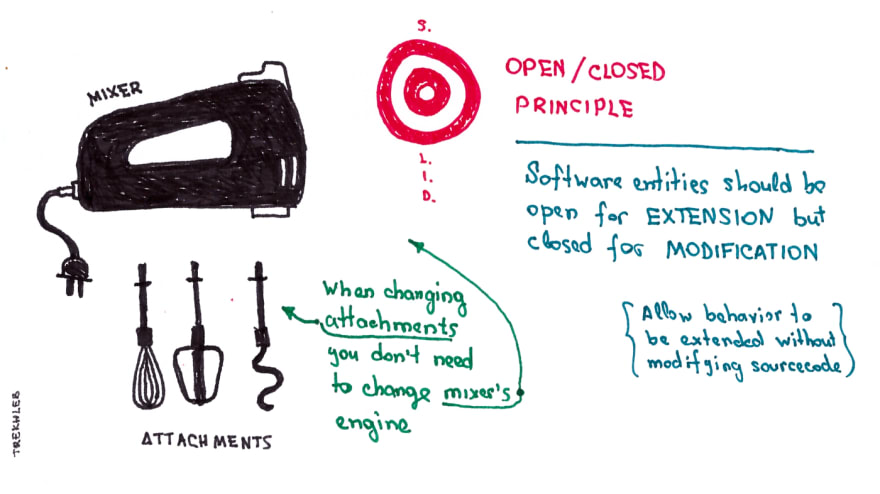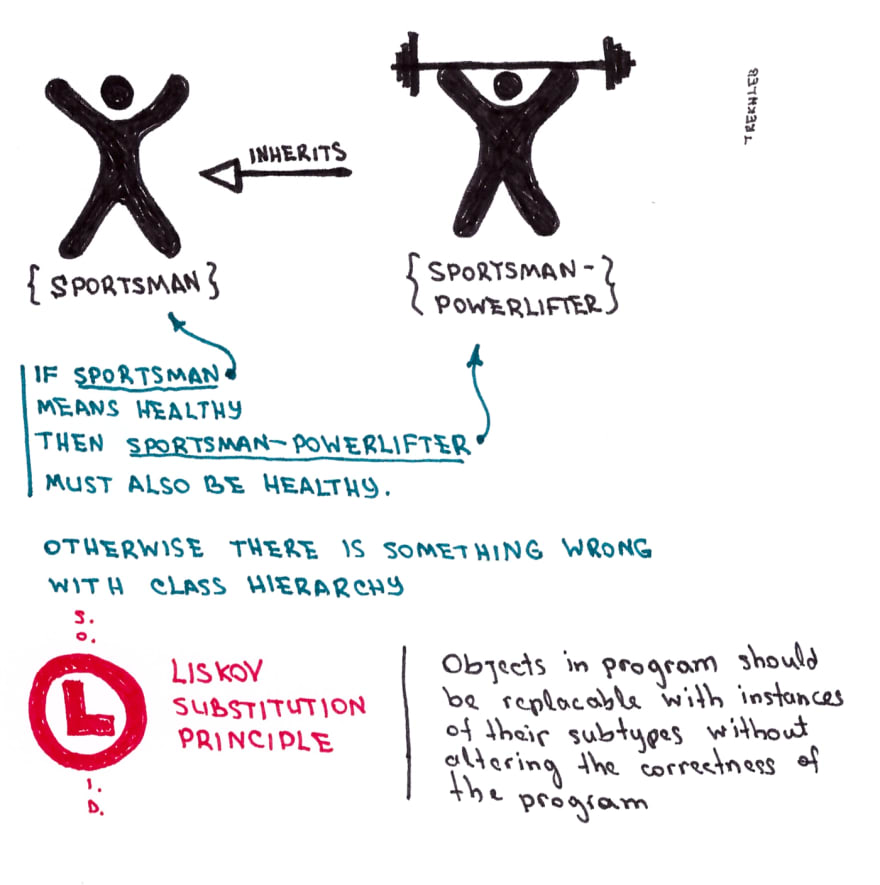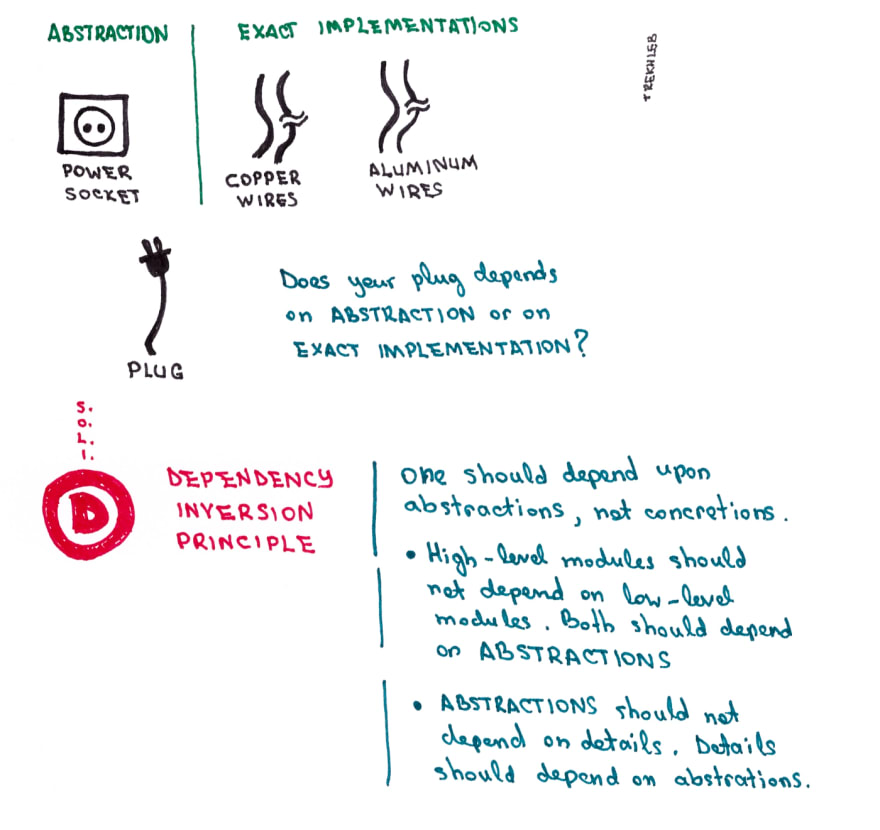S.O.L.I.D. Principles Around You - DEV Community
#programming #software-development #object-oriented-design

In this article, I want to briefly go through SOLID principles (the acronym that stands for five basic principles of object-oriented programming and design) supplying each of them with real-world visual examples to make those principles more understandable, readable and memorizable.
If you want to see code examples instead you may take a look at variety of tree data structure implementations in JavaScript like Binary Search Tree, AVL Tree, Red-Black Tree, Segment Tree or Fenwick Tree.
So let’s move on!
S — Single Responsibility Principle
[a.k.a SRP] A class should have only a single responsibility. Only one potential change in the software’s specification should be able to affect the specification of the class.
O — Open/Closed Principle
[a.k.a OCP] Software entities should be open for EXTENSION, but closed for MODIFICATION. Allow behavior to be extended without modifying the source code.
L — Liskov Substitution Principle
[a.k.a. LSP] Objects in a program should be replaceable with instances of their subtypes without altering the correctness of that program.
I — Interface Segregation Principle
[a.k.a. ISP] Many client-specific interfaces are better than one general-purpose interface. No client should be forced to depend on methods it does not use.
D — Dependency Inversion Principle
[a.k.a. DIP] One should depend upon abstractions, not concretions.
- High-level modules should not depend on low-level modules. Both should depend on abstractions.
- Abstractions should not depend on details. Details should depend on abstractions.
The plug doesn’t care which type of wire it uses, it just needs wires that conduct electricity.
I hope these illustrations have been useful for you :)
{
"type": "file",
"name": "S.O.L.I.D. Principles - DEV Community.md",
"path": "/resources/articles/S.O.L.I.D. Principles - DEV Community.md",
"modTime": "2025-10-22T15:24:29.758Z",
"mime": "application/markdown",
"size": 5757,
"content": {
"_schema": "Article",
"_type": "Article",
"articleBody": "#programming #software-development #object-oriented-design\n\n\nIn this article, I want to briefly go through [SOLID](https://en.wikipedia.org/wiki/SOLID_(object-oriented_design)) principles (the acronym that stands for five basic principles of object-oriented programming and design) supplying each of them with real-world visual examples to make those principles more understandable, readable and memorizable.\n\n> If you want to see code examples instead you may take a look at [variety of tree data structure implementations](https://github.com/trekhleb/javascript-algorithms/tree/master/src/data-structures/tree) in **JavaScript** like [Binary Search Tree](https://github.com/trekhleb/javascript-algorithms/tree/master/src/data-structures/tree/binary-search-tree), [AVL Tree](https://github.com/trekhleb/javascript-algorithms/tree/master/src/data-structures/tree/avl-tree), [Red-Black Tree](https://github.com/trekhleb/javascript-algorithms/tree/master/src/data-structures/tree/red-black-tree), [Segment Tree](https://github.com/trekhleb/javascript-algorithms/tree/master/src/data-structures/tree/segment-tree) or [Fenwick Tree](https://github.com/trekhleb/javascript-algorithms/tree/master/src/data-structures/tree/fenwick-tree).\n\nSo let’s move on!\n\n## [](https://dev.to/trekhleb/s-o-l-i-d-principles-around-you-1o17#s-single-responsibility-principle)S — Single Responsibility Principle\n\n\\[a.k.a [SRP](https://en.wikipedia.org/wiki/Single_responsibility_principle)\\] A class should have only a single responsibility. Only one potential change in the software’s specification should be able to affect the specification of the class.\n\n[](https://res.cloudinary.com/practicaldev/image/fetch/s--Qh1_I3hH--/c_limit%2Cf_auto%2Cfl_progressive%2Cq_auto%2Cw_880/https://dev-to-uploads.s3.amazonaws.com/i/xabfs57cezxegih8uh2f.png)\n\n## [](https://dev.to/trekhleb/s-o-l-i-d-principles-around-you-1o17#o-openclosed-principle)O — Open/Closed Principle\n\n\\[a.k.a [OCP](https://en.wikipedia.org/wiki/Open/closed_principle)\\] Software entities should be open for EXTENSION, but closed for MODIFICATION. Allow behavior to be extended without modifying the source code.\n\n[](https://res.cloudinary.com/practicaldev/image/fetch/s--pagpCyfX--/c_limit%2Cf_auto%2Cfl_progressive%2Cq_auto%2Cw_880/https://dev-to-uploads.s3.amazonaws.com/i/fv3xpd9kkfgntqby9eg6.png)\n\n## [](https://dev.to/trekhleb/s-o-l-i-d-principles-around-you-1o17#l-liskov-substitution-principle)L — Liskov Substitution Principle\n\n\\[a.k.a. [LSP](https://en.wikipedia.org/wiki/Liskov_substitution_principle)\\] Objects in a program should be replaceable with instances of their subtypes without altering the correctness of that program.\n\n[](https://res.cloudinary.com/practicaldev/image/fetch/s--ArU0mGdu--/c_limit%2Cf_auto%2Cfl_progressive%2Cq_auto%2Cw_880/https://dev-to-uploads.s3.amazonaws.com/i/7wdzib8lqfq9bcstfqu3.png)\n\n## [](https://dev.to/trekhleb/s-o-l-i-d-principles-around-you-1o17#i-interface-segregation-principle)I — Interface Segregation Principle\n\n\\[a.k.a. [ISP](https://en.wikipedia.org/wiki/Interface_segregation_principle)\\] Many client-specific interfaces are better than one general-purpose interface. No client should be forced to depend on methods it does not use.\n\n[](https://res.cloudinary.com/practicaldev/image/fetch/s--58sXrCsO--/c_limit%2Cf_auto%2Cfl_progressive%2Cq_auto%2Cw_880/https://dev-to-uploads.s3.amazonaws.com/i/rnwds5cv5qcodlam1wc6.png)\n\n## [](https://dev.to/trekhleb/s-o-l-i-d-principles-around-you-1o17#d-dependency-inversion-principle)D — Dependency Inversion Principle\n\n\\[a.k.a. [DIP](https://en.wikipedia.org/wiki/Dependency_inversion_principle)\\] One should depend upon abstractions, not concretions.\n\n- High-level modules should not depend on low-level modules. Both should depend on abstractions.\n- Abstractions should not depend on details. Details should depend on abstractions.\n\n[](https://res.cloudinary.com/practicaldev/image/fetch/s--yw39zKqE--/c_limit%2Cf_auto%2Cfl_progressive%2Cq_auto%2Cw_880/https://dev-to-uploads.s3.amazonaws.com/i/wugaxuqznqow3wzgp8hr.png)\n\nThe plug doesn’t care which type of wire it uses, it just needs wires that conduct electricity.\n\nI hope these illustrations have been useful for you :)\n",
"author": {
"_type": "Person",
"name": "twitter:Trekhleb"
},
"headline": "S.O.L.I.D. Principles Around You - DEV Community",
"reviewRating": {
"bestRating": 5,
"worstRating": 1
},
"url": "https://dev.to/trekhleb/s-o-l-i-d-principles-around-you-1o17"
}
}



